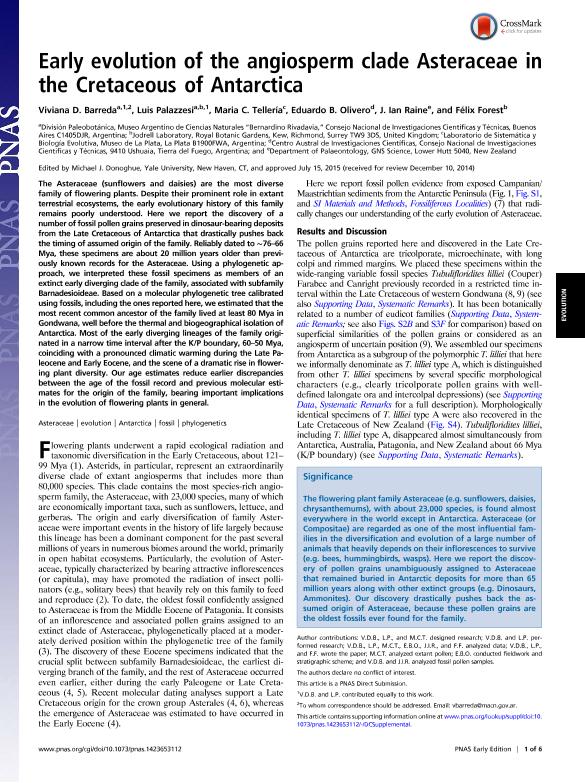Mostrar el registro sencillo del ítem
dc.contributor.author
Barreda, Viviana Dora

dc.contributor.author
Palazzesi, Luis

dc.contributor.author
Telleria, Maria Cristina

dc.contributor.author
Olivero, Eduardo Bernardo

dc.contributor.author
Raine, Ian
dc.contributor.author
Forest, Félix
dc.date.available
2016-09-07T19:22:48Z
dc.date.issued
2015-08
dc.identifier.citation
Barreda, Viviana Dora; Palazzesi, Luis; Telleria, Maria Cristina; Olivero, Eduardo Bernardo; Raine, Ian; et al.; Early evolution of the angiosperm clade Asteraceae in the Cretaceous of Antarctica; National Academy Of Sciences; Proceedings Of The National Academy Of Sciences Of The United States Of America; 112; 35; 8-2015; 10989-10994
dc.identifier.issn
0027-8424
dc.identifier.uri
http://hdl.handle.net/11336/7528
dc.description.abstract
The Asteraceae (sunflowers and daisies) are the most diversefamily of flowering plants. Despite their prominent role in extantterrestrial ecosystems, the early evolutionary history of this familyremains poorly understood. Here we report the discovery of anumber of fossil pollen grains preserved in dinosaur-bearing depositsfrom the Late Cretaceous of Antarctica that drastically pushes backthe timing of assumed origin of the family. Reliably dated to ∼76?66Mya, these specimens are about 20 million years older than previouslyknown records for the Asteraceae. Using a phylogenetic approach,we interpreted these fossil specimens as members of anextinct early diverging clade of the family, associated with subfamilyBarnadesioideae. Based on a molecular phylogenetic tree calibratedusing fossils, including the ones reported here, we estimated that themost recent common ancestor of the family lived at least 80 Mya inGondwana, well before the thermal and biogeographical isolation ofAntarctica. Most of the early diverging lineages of the family originatedin a narrow time interval after the K/P boundary, 60?50 Mya,coinciding with a pronounced climatic warming during the Late Paleoceneand Early Eocene, and the scene of a dramatic rise in floweringplant diversity. Our age estimates reduce earlier discrepanciesbetween the age of the fossil record and previous molecular estimatesfor the origin of the family, bearing important implicationsin the evolution of flowering plants in general.
dc.format
application/pdf
dc.language.iso
eng
dc.publisher
National Academy Of Sciences

dc.rights
info:eu-repo/semantics/openAccess
dc.rights.uri
https://creativecommons.org/licenses/by-nc-sa/2.5/ar/
dc.subject
Asteraceae
dc.subject
Evolution
dc.subject
Antarctica
dc.subject
Fossil
dc.subject
Phylogenetics
dc.subject.classification
Paleontología

dc.subject.classification
Ciencias de la Tierra y relacionadas con el Medio Ambiente

dc.subject.classification
CIENCIAS NATURALES Y EXACTAS

dc.title
Early evolution of the angiosperm clade Asteraceae in the Cretaceous of Antarctica
dc.type
info:eu-repo/semantics/article
dc.type
info:ar-repo/semantics/artículo
dc.type
info:eu-repo/semantics/publishedVersion
dc.date.updated
2016-04-01T17:26:53Z
dc.journal.volume
112
dc.journal.number
35
dc.journal.pagination
10989-10994
dc.journal.pais
Estados Unidos

dc.journal.ciudad
Washington
dc.description.fil
Fil: Barreda, Viviana Dora. Consejo Nacional de Investigaciones Científicas y Técnicas. Oficina de Coordinación Administrativa Parque Centenario. Museo Argentino de Ciencias Naturales; Argentina
dc.description.fil
Fil: Palazzesi, Luis. Consejo Nacional de Investigaciones Científicas y Técnicas. Oficina de Coordinación Administrativa Parque Centenario. Museo Argentino de Ciencias Naturales; Argentina. Royal Botanic Gardens; Reino Unido
dc.description.fil
Fil: Telleria, Maria Cristina. Universidad Nacional de la Plata. Facultad de Ciencias Naturales y Museo; Argentina
dc.description.fil
Fil: Olivero, Eduardo Bernardo. Consejo Nacional de Investigaciones Científicas y Técnicas. Centro Austral de Investigaciones Científicas; Argentina
dc.description.fil
Fil: Raine, Ian. GNS SCIENCE; Nueva Zelanda
dc.description.fil
Fil: Forest, Félix. Royal Botanic Gardens; Reino Unido
dc.journal.title
Proceedings Of The National Academy Of Sciences Of The United States Of America

dc.relation.alternativeid
info:eu-repo/semantics/altIdentifier/url/http://www.pnas.org/content/112/35/10989.short
dc.relation.alternativeid
info:eu-repo/semantics/altIdentifier/doi/http://dx.doi.org/10.1073/pnas.1423653112
Archivos asociados
